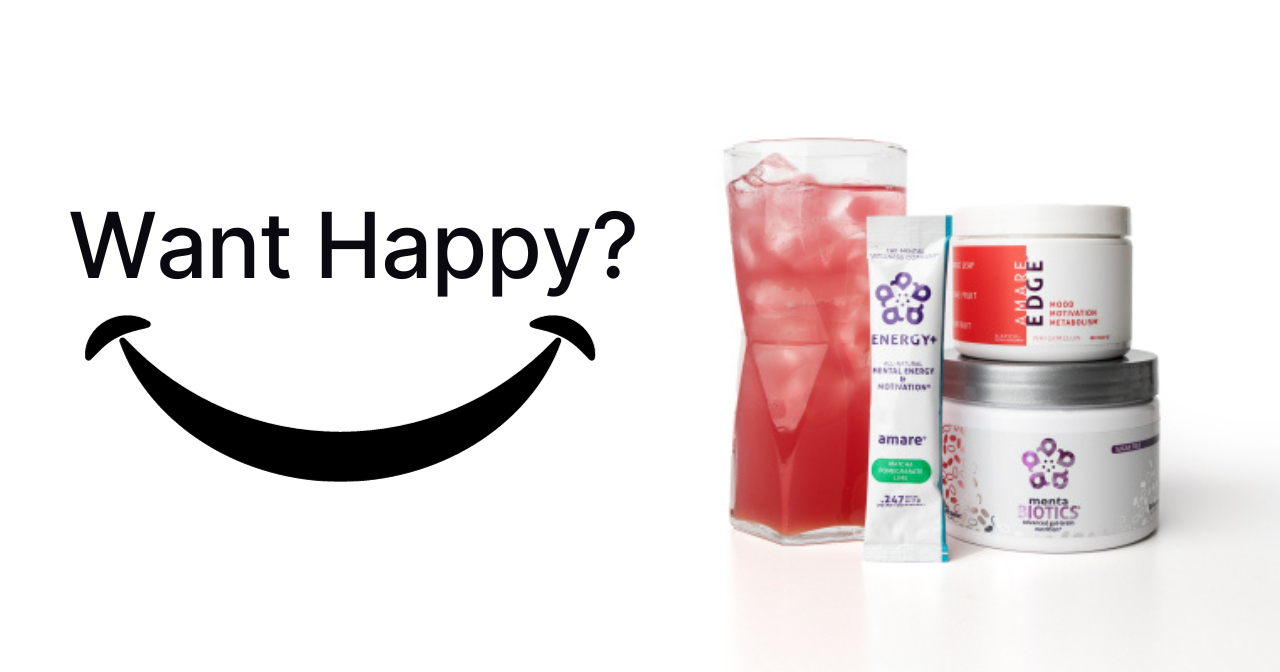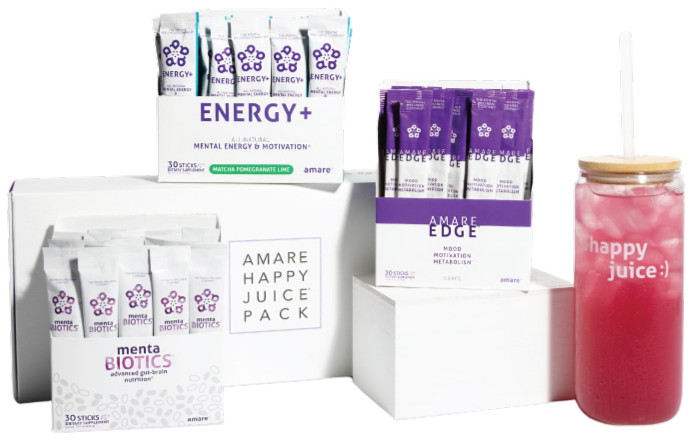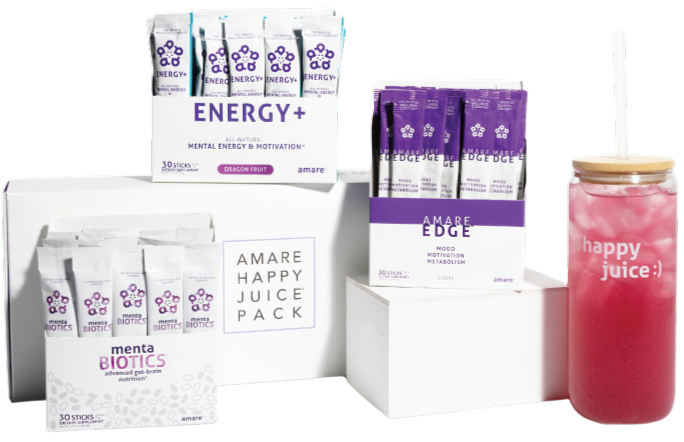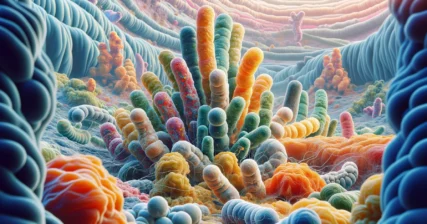Chances are, if a friend hasn’t talked to you about Happy Juice yet, somebody will soon. And for good reason. Happy Juice just might be the best-tasting, fastest-acting mental wellness supplement there is. But what is Happy Juice?
Happy Juice is Amare Global’s signature supplement pack. It’s become so popular that many people think it’s the only thing Amare offers. But that’s not the case. In fact, there are many other powerful, popular products for your needs beyond mental sharpness, clarity, focus, and calmness.
This delicious combination of three of our most popular products earned the nickname “Happy Juice” with our customers! Combine EDGE, MentaBiotics, and Energy+ in one drink to elevate your mood, crush your to-do list, and enjoy every minute of the day!
In this article, though, we’ll focus on Happy Juice: who it’s for, why it works, and how you can get started with experiencing more happiness right away.
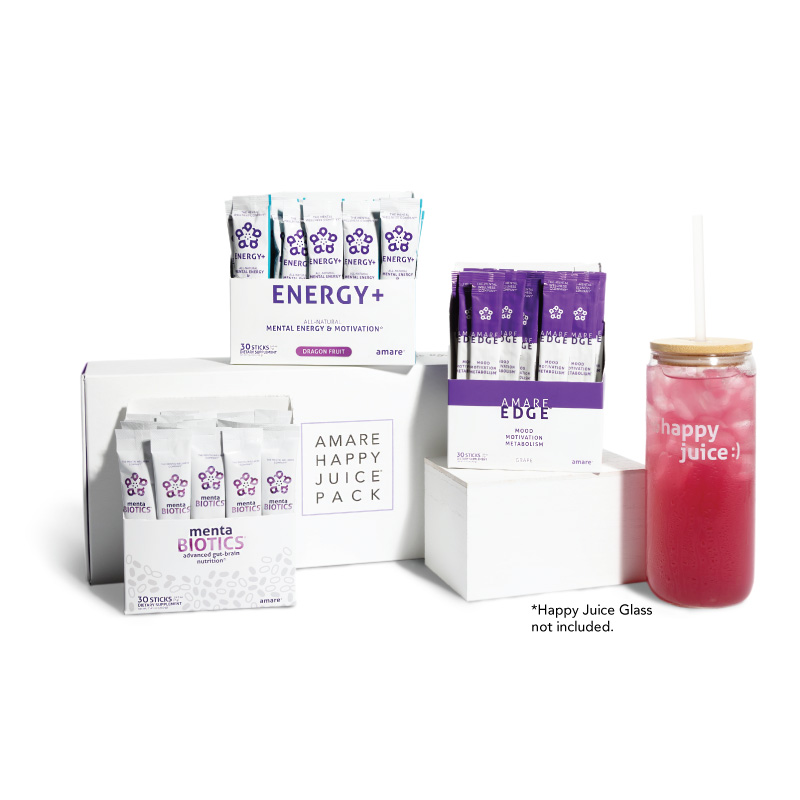
Feel Better Fast. Guaranteed.
Energy+, EDGE, and MentaBiotics make up the Happy Juice supplement stack, with ingredients clinically proven to:
- decrease anxiousness scores by 55%
- decrease irritability scores by 60%
- decrease fatigue by 64%
- decrease anger 54%
- decrease tension by 45%
- decrease confusion by 43%
- decrease overall distress by 49%
- increase good bacteria by 70%
- decrease negative mood by 105%
- increase positive mood by 211%
What is Happy Juice?
Happy Juice is a combination of two or three different Amare products – Energy+, Amare EDGE, and MentaBiotics – mixed together to create a synergistic supplement stack that supports the function of your brain, gut, and the gut-brain axis. This potent combination of all-natural ingredients works together to improve your mood, enhance your mental focus, increase your energy levels, and boost your cognitive function. And, to make it easy to take with you, Amare Happy Juice, comes in convenient stick packs.
Amare Happy Juice delivers mental and physical health benefits in phases, with Energy+ acting within hours to days, Amare EDGE acting within days to weeks, and MentaBiotics acting in weeks to months. Each of the three supplements is incredible on its own, but when used together, they pack a more powerful, synergistic punch, improving function of your first brain, your second brain (your gut), and the gut-brain axis, or the communication network between the two.
Amare Happy Juice Pack Options
Not only do the Happy Juice supplements act synergistically, but you also get a discounted price when ordering them as a pack instead of individual items. The following are the three Happy Juice pack options.
All Happy Juice Packs offer similar mental and emotional benefits. However, each has a different formula, which adds a unique edge to it. Start with one, try them all.
The Science Behind the Happy Juice Supplements and the Gut-Brain Axis
The following section provides a detailed explanation of the individual supplements and their ingredients that make up the Happy Juice Packs. You’ll see why these Amare product packs deliver such rapid improvements in mental fitness.
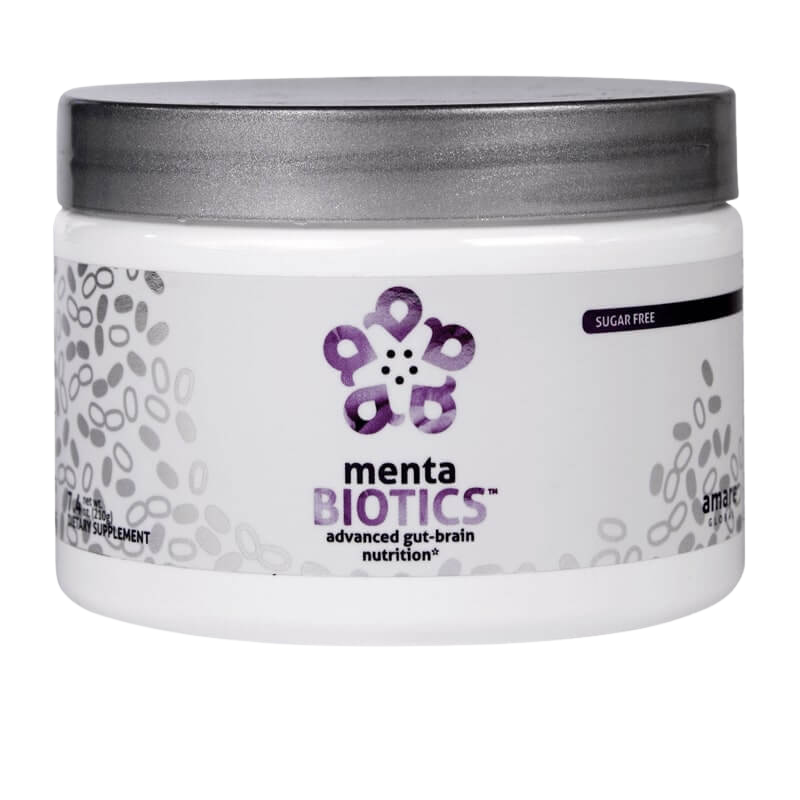
MentaBiotics
Included in all Happy Juice Packs, MentaBiotics is the most comprehensive combination of unique strains of probiotics, prebiotics, and phytobiotics that have been scientifically shown to improve mental wellness.
MentaBiotics contains specific probiotic strains shown to improve mental wellness, in part by increasing production of the neurotransmitters GABA, serotonin, and dopamine. It includes the following ingredients:
Lactobacillus rhamnosus R0011: Lactobacillus rhamnosus R0011 is a specific probiotic strain known for its positive impact on digestive health, enhancing gut flora balance and aiding in the prevention and treatment of diarrhea.1 Lactobacillus rhamnosus R0011 has been linked to reduced symptoms of anxiety and depression.2 It reduces stress by lowering cortisol exposure and improves GABA neurotransmission. Additionally, it can help in managing allergies and improving skin health.3
Bifidobacterium longum R0175: Bifidobacterium longum R0175 is known for its positive effects on the immune system, helping to prevent and fight infections. Bifidobacterium longum R0175 has been linked to reduced stress and anxiety.4 It has been linked to reducing stress and improving mood by affecting serotonin, another key neurotransmitter involved in feelings of happiness and well-being.5 It also contributes to improved mood and cognitive function, vital for overall mental health and resilience.
Lactobacillus helveticus R0052: Lactobacillus helveticus R0052 is a powerhouse probiotic with far-reaching benefits for both physical and mental health. This strain excels in enhancing gut health, which is fundamental for effective digestion and nutrient absorption.6 Its impact on gut health is also linked to a stronger immune system, helping your body to better fend off illnesses. On the mental health side, Lactobacillus helveticus R0052 has been shown to reduce stress and anxiety.7 Studies have shown that Lactobacillus helveticus R0052 can regulate levels of GABA, an important neurotransmitter that helps control feelings of fear and anxiety.8
Bimuno® (Galacto-Oligo-Saccharides): Bimuno®, a prebiotic supplement containing Galacto-Oligosaccharides (GOS), nurtures beneficial bacteria in the digestive system, essential for proper digestion.9 It’s especially helpful for feeding Bifidobacteria strains. Also, a healthy gut microbiome, supported by GOS, is linked to reduced stress and improved mood.10 Additionally, Bimuno® may help manage weight by promoting satiety and reducing overeating.11
SunFiber® (Galactomannan fiber): SunFiber, made from Galactomannan fiber, is a remarkable supplement feeding good gut bacteria. When Sunfiber reaches the large intestine, the beneficial bacteria there start to ferment it. This fermentation process is crucial because it allows these bacteria to thrive and multiply. The fermentation of Sunfiber by gut bacteria produces short-chain fatty acids (SCFAs), like butyrate, acetate, and propionate. These SCFAs have various health benefits, such as strengthening the gut barrier and reducing inflammation. SunFiber also aids in maintaining a healthy weight by promoting satiety.12 For fitness enthusiasts, regular intake of SunFiber® can enhance workout performance through better digestion and energy utilization. Including SunFiber® in your diet is a smart strategy for anyone looking to boost their overall health, enhance mental clarity, and maintain physical fitness.
MentaBiotics also contains IsoFiber Prebiotic Fiber, which I reviewed in the section on Amare EDGE, and a variety of phytobiotics that further help the probiotics to thrive in your gut.
The ingredients above have been clinically shown to result in:
- 60% decrease in irritability scores*
- 55% decrease in anxiousness scores*
- 50% decrease in negative mood scores*
- 49% reduction in overall distress*
- 70% increase in good bacteria*
- 211% improvement in positive mood and 105% decrease in negative mood*
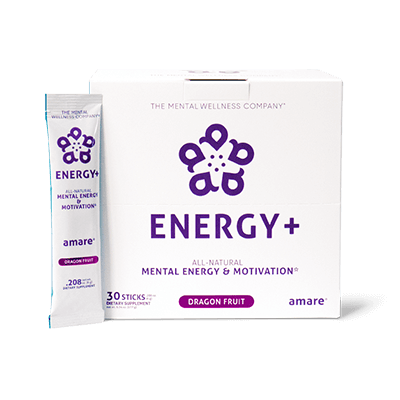
Energy+
Included in Pomegranate Lime (Caffeinated) or Dragon Fruit (Caffeine-Free) Happy Juice.
Energy+ gives you three types of energy:
- Physical energy
- Mental energy
- Mental awareness
It also comes in two slightly different formulas, with one containing 55 mg of caffeine and the other being caffeine-free.
Of the three supplements in Amare Happy Juice, you’ll feel the effects of Energy+ the fastest. I, as have many others who’ve ordered Happy Juice, noticed a difference in mental clarity and energy within about a half hour of using it the first time. That’s been the case almost every day since then.
Energy+ Dragon Fruit (caffeine-free)
This caffeine-free version of Energy+ contains chicory root inulin, glycine, Pomegranate fruit extract, Rooibos Tea leaf, Asian Apple fruit extract, French Grape seed extract, and New Zealand Pine bark extract. Here’s the science behind each ingredient. It helps create a “relaxed energy” version of Happy Juice.
The ingredients in Dragon Fruit Energy+ include:
Chicory root inulin: Chicory root inulin, a type of dietary fiber, aids in weight management by promoting a feeling of fullness, reducing overall food intake.13 Mentally, inulin has been linked to improved mood and cognitive functions.14 Inulin also supports gut health by enhancing the growth of beneficial bacteria.15
Glycine: Glycine, an amino acid, helps in muscle repair and growth as well as collagen synthesis.16 Glycine has shown promise in improving sleep quality and reducing fatigue.17 It also plays a role in cognitive function, helping to enhance memory and attention.18 Furthermore, glycine supports gut health and can aid in reducing inflammation.19
Rooibos: Rooibos tea leaf is known for its antioxidant properties, which are crucial in fighting inflammation and supporting overall health. These antioxidants also contribute to improved heart health by reducing blood pressure and cholesterol.20 Mentally, rooibos tea has been linked to stress reduction, thanks to its ability to lower cortisol levels.21 Additionally, rooibos tea can improve sleep quality.22
The next group of ingredients are included in both Energy+ Formulas, even though I’m only including them in this section.
Pomegranate Extract: Pomegranate extract is another antioxidant-rich botanical, making it beneficial for heart health, as it helps improve blood flow and slow arterial plaque buildup.23 Pomegranate extract has been linked to improved memory and cognitive function and may also enhance exercise performance and muscle recovery.24,25
Applephenon® Asian apple fruit extract: Applephenon, derived from Asian apple fruit extract, is known for its high concentration of polyphenols, which are powerful antioxidants. These compounds play a crucial role in reducing oxidative stress and inflammation.26 This extract helps regulate metabolism and fat accumulation.27 Applephenon protects brain cells against oxidative stress which supports cognitive function. Additionally, it supports cardiovascular health by improving blood flow and reducing the risk of heart disease.28
Enovita® French Grape seed extract: Enovita is rich in oligomeric proanthocyanidins (OPCs), potent antioxidants that plays a key role in combating oxidative stress and supporting normal inflammation levels.29 Enovita® improves cardiovascular health by enhancing blood circulation and reducing blood pressure.30 Its antioxidant properties may also contribute to improved cognitive function.31
Enzogenol® New Zealand pine bark extract: Enzogenol®, derived from New Zealand pine bark, is packed with bioflavonoids and other antioxidants, which are key in reducing oxidative stress and inflammation.32 Also, Enzogenol® has been associated with improved cognitive functions, including enhanced memory and concentration.33 Additionally, it supports joint health, which is particularly beneficial for those engaged in physical fitness.34
Energy+ Pomegranate Lime
The caffeinated version of Energy+ contains Pomegranate, Applephenon, Enovita, and Enzogenol like the caffeine-free version, but the remaining active ingredients differ from the caffeine-free dragonfruit flavor. They include:
Amatea Guayusa Extract: Amatea™ Guayusa Extract, derived from a unique Amazonian leaf, is a natural source of caffeine, providing a smooth energy boost without the jitters often associated with other caffeinated beverages.35 This makes it an excellent choice for improving exercise performance and mental alertness. Additionally, Guayusa is rich in antioxidants, which play a crucial role in reducing oxidative stress and supporting healthy levels of inflammation.36 These antioxidant properties also contribute to cardiovascular health by improving blood circulation and heart function. Though Guayusa increases energy with its caffeine, it also calms the mind at the same time with its l-theanine, reducing stress and improving mood.37
Matcha Green Tea: Matcha Green Tea, a highly regarded form of green tea, is rich in catechins, particularly epigallocatechin gallate (EGCG). Matcha is a potent antioxidant, helping to reduce oxidative stress and normalize inflammation levels.38 Furthermore, matcha has been linked to improved cardiovascular health by aiding in cholesterol regulation.39 On the mental health side, matcha contains L-theanine, which promotes relaxation and reduces stress without drowsiness.40 Additionally, matcha can enhance cognitive function and alertness, which is essential for both mental acuity and physical performance.41
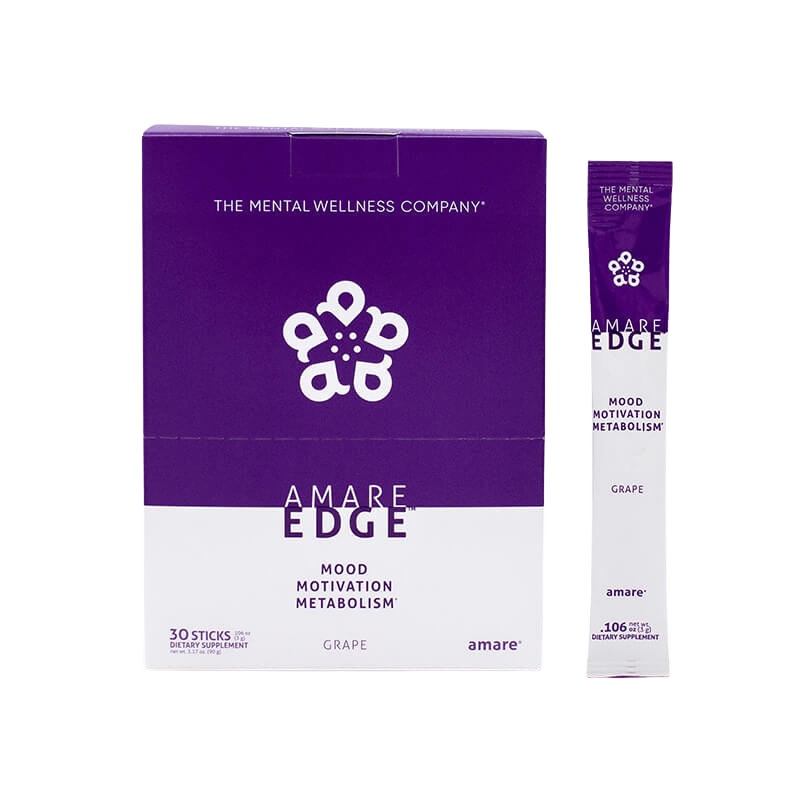
Amare EDGE
Included in Dragon Fruit and Pomegranate Lime Happy Juice.
Amare EDGE is a powerful all-natural nootropic that supports mental flow, body and mind endurance, and enhanced neuron regeneration. EDGE is formulated to help with brain plasticity and your ability to learn and form new neural connections. It helps give you the motivation to crush your to-do list and tackle your day with ease. Kinda like your secret superpower. EDGE comes in either grape or watermelon flavors, but the active ingredients are exactly the same.
Nootropics are supplements that positively impact mental skills, such as executive functions, attention, memory, creativity, and motivation. Unlike many synthetic nootropics, there are no significant side effects with EDGE.
You’ll start feeling the effects of EDGE within days to weeks of regular use, which are often described as a lifting of brain fog, increased motivation, and an increased ability to handle stressors and unexpected situations in your day-to-day. The following are EDGE’s active ingredients:
Zynamite® Mango Leaf Extract: Rich in mangiferin, a natural bioactive compound, Zynamite has shown to be effective in enhancing brain function and reducing mental fatigue.42 Physically, Zynamite supports exercise performance by increasing energy and endurance.43 It also has anti-inflammatory properties, which are beneficial for recovery and overall physical health.44
Oligonol® Lychee Fruit Extract: Oligonol Lychee Fruit Extract, a unique polyphenol-rich supplement, possesses potent antioxidant properties, which combat oxidative stress and inflammation. Oligonol also aids in improving blood circulation and cardiovascular health45 Supplementation enhances physical endurance and reduces fatigue.46 The antioxidants in Oligonol contribute to cognitive health and may improve mental alertness.47
Palm Fruit Bioactives Complex (PFBc®): Palm Fruit Bioactives Complex (PFBc®) is a rich source of tocotrienols and carotenoids, potent antioxidants. PFBc® plays a significant role in heart health, helping to maintain healthy cholesterol levels and inflammation.48 PFBc® aids in muscle recovery and overall physical performance.49
IsoFiber Prebiotic Fiber: IsoFiber Prebiotic Fiber (Iso-Malto-Oligosaccharides) is a standout for supporting both physical and mental health. As a prebiotic, IMOs are fantastic for gut health, fostering beneficial gut bacteria, which is key for digestion and overall well-being.50 Enhanced gut health from IMOs leads to better nutrient absorption and strengthens the immune system, vital for maintaining physical health. A robust gut microbiome, supported by IMOs, has been linked to improved mood and cognitive function.51 Additionally, IMOs contribute to weight management by promoting feelings of fullness and reducing overeating.52
Amare EDGE+
This upgraded EDGE formula, new in 2024, includes three new ingredients, which include Lion’s Mane, Citocoline, and Natural Caffeine from Green Coffee Bean Extract.
To learn about the benefits of the new formula, check out my article: Amare EDGE+: The All-Natural, Upgraded Nootropic.
EDGE+ is exclusively found in the Amare Happy Juice Pack Mango.
Who would benefit from Happy Juice?
I suppose a better question to ask would be, “Who wouldn’t benefit from Happy Juice?”
Clearly, this supplement trio significantly impacts mental wellness, from improving mental clarity, focus, and energy, to enhancing motivation and metabolism, to decreasing tension, irritability, stress, and anxious feelings. Who wouldn’t want that?
Even if someone’s life is good and stress is minimal, most of us would love the mental edge Happy Juice provides. That’s why almost everyone I talk to (other than hardcore skeptics) says, “show me how to get some Happy Juice.”
If you’re thinking the same thing, tap here to get your Happy Juice.
How to Get Started
Ordering your Happy Juice is simple and straightforward.
- Tap this link to get on the Happy Juice page and choose your flavors.
- Both EDGE flavors are caffeine-free. Pomegrantate Lime EDGE+ has 55 mg of caffeine, whereas Dragon Fruit is caffeine-free
- Add it to your cart and either add other supplements or check out.
- You’ll see an option to order as a customer or a brand partner. If you’d like to share Amare with others and earn an income, choose the brand partner option. If you’re not interested in that, check out as a customer.
- Send me an email and let me know you’ve ordered so I can send you some free resources to jump-start your Happy Juice experience.
How do you make Happy Juice?
Making Happy Juice is the easiest thing you’ll do all day.
Simply cut or tear the tops off each of the stick packs, dump them into a large glass of water or a shaker cup. Add some ice if you’d like it colder. Then, mix it up and start feeling more energy, focus, stamina, and motivation!
According to the directions on the site, you can “Mix into water, a smoothie, fruit juice or your favorite beverage. For extra edge, consider a double scoop. Additional scoops may be consumed as desired.” I wouldn’t recommend mixing Happy Juice with anything but water as the three supplements in water make for a delicious combination already.
You’ll notice Amare’s extensive use of branded or trademarked ingredients. This is a key feature of their formulas. Here’s why the branded ingredients add so much value to Amare supplements:
- Quality Assurance: Branded ingredients often come with a higher level of quality assurance. Manufacturers of branded ingredients usually invest in clinical studies and quality control processes to ensure their product is effective and safe. This means that when you choose a supplement with a branded ingredient, you’re likely getting a product that’s been thoroughly tested and proven.
- Consistency: With branded ingredients, there’s a higher likelihood of consistency in the product. These ingredients are typically produced using standardized processes, ensuring that each batch has the same potency and purity. This consistency can be crucial for achieving the desired health benefits.
- Research and Development: Branded ingredients are often the result of extensive research and development. The investment in R&D not only ensures a high-quality product but also often means that the ingredient is backed by scientific research demonstrating its efficacy. And they’re often created in a way that offers superior bioavailability, meaning more of that ingredient gets into your body, leading to a positive physiological change.
- Traceability and Transparency: Manufacturers of branded ingredients usually provide greater transparency about the source and production of their ingredients. This can be particularly important for those concerned about where their supplements come from and how they are made.
- Efficacy: When a supplement brand uses trademarked ingredients in their formulas, they agree to use a minimum, efficacious dose. The ingredient supplier wouldn’t want companies using their ingredients to look good on the label and end up delivering no benefit. So, unlike when using generic ingredients, you know that you’re getting enough of that ingredient to make a significant difference in your health and fitness.
That’s not to say all generic ingredients are inferior. But it is to say that when a supplement uses branded ingredients, it’s likely to be the best of its kind available. Again, that’s a big reason why I got so excited about Amare supplements when I first looked into them.
Frequently Asked Questions
The following are the most common questions we receive before people order. I’ll update this if other frequent questions come up.
You’ll get a 30-day supply of each product.
The Pomegranate Lime Energy+ (the caffeinated one) has 5 grams of sugar. None of the other products have any.
Yes, to gain all the benefits. Each is unique, and enhances your mental wellness in different ways and in a phased timeline. To get the best mental wellness benefits, use all three for at least a few months.
Fruity and slightly sweet. You can always dilute with more water if you want to make it less sweet.
Once or twice a day.
Although Energy+ can be made hot or cold alone, you don’t want to heat up the MentaBiotics in Amare Happy Juice. The heat can kill the probiotics.
Absolutely. Actually, teens are the top consumers of energy drinks, so Happy Juice would be a much healthier, safer, and more effective option. Plus, it can help improve their mood and focus.
Absolutely. There’s significant research showing the benefit of supplementing with probiotics like those in the Happy Juice pack after a round of antibiotics.
Yes, a 90-day money-back guarantee.
Yes, if you read through the research and benefits I outlined in the ingredients section, you’ll see why it’s helpful for weight management.
Yes! When you use one of my links on this page, you’ll get $10 off your first order. In addition, you can enjoy more Amare products with greater savings and discounts through our Subscribe & Save and Bundle & Save programs!. PLUS, when you purchase any Amare product pack on Subscribe & Save, you can bundle up to 3 additional products at a reduced price of up to 54% off ! That means MORE Amare at a discounted price!
Just the standard stuff: Do not expose to boiling or scalding temperatures. . Store in a cool, dry place. Keep out of reach of children. Consult your physician if you are pregnant, nursing, taking a prescription drug, or have a medical condition.
Let’s Get Happy Together!
I’d love to have you join us on this mental wellness journey. You can start with just Happy Juice, or order one of the larger packs and hit more of your mental and physical wellness bases. Give it a try for 90 days. You’ve got nothing to lose and a less stressed, more exciting life to gain.
Tap to Order Happy Juice, and send me a message after you order so I can send you some happy resources!

Feel Better Fast. Guaranteed.
Energy+, EDGE, and MentaBiotics make up the Happy Juice supplement stack, with ingredients clinically proven to:
- decrease anxiousness scores by 55%
- decrease irritability scores by 60%
- decrease fatigue by 64%
- decrease anger 54%
- decrease tension by 45%
- decrease confusion by 43%
- decrease overall distress by 49%
- increase good bacteria by 70%
- decrease negative mood by 105%
- increase positive mood by 211%
- Plummer, S., Weaver, M. A., Harris, J. C., Dee, P., & Hunter, J. (2001). Clostridium difficile pilot study: Effects of probiotic supplementation on the incidence of C. difficile diarrhoea. International Microbiology, 4(1), 29-32. ↩︎
- Bravo, J. A., Forsythe, P., Chew, M. V., Escaravage, E., Savignac, H. M., Dinan, T. G., Bienenstock, J., & Cryan, J. F. (2011). Ingestion of Lactobacillus strain regulates emotional behavior and central GABA receptor expression in a mouse via the vagus nerve. Proceedings of the National Academy of Sciences, 108(38), 16050-16055. ↩︎
- Isolauri, E., Arvola, T., Sütas, Y., Moilanen, E., & Salminen, S. (2000). Probiotics in the management of atopic eczema. Clinical & Experimental Allergy, 30(11), 1604-1610. ↩︎
- Messaoudi, M., Lalonde, R., Violle, N., Javelot, H., Desor, D., Nejdi, A., Bisson, J. F., Rougeot, C., Pichelin, M., Cazaubiel, M., & Cazaubiel, J. M. (2011). Assessment of psychotropic-like properties of a probiotic formulation (Lactobacillus helveticus R0052 and Bifidobacterium longum R0175) in rats and human subjects. British Journal of Nutrition, 105(5), 755-764. ↩︎
- Messaoudi, M., Lalonde, R., Violle, N., Javelot, H., Desor, D., Nejdi, A., Bisson, J. F., Rougeot, C., Pichelin, M., Cazaubiel, M., & Cazaubiel, J. M. (2011). Assessment of psychotropic-like properties of a probiotic formulation (Lactobacillus helveticus R0052 and Bifidobacterium longum R0175) in rats and human subjects. British Journal of Nutrition, 105(5), 755-764. ↩︎
- Donnet-Hughes, A., Perez, P. F., Doré, J., Leclerc, M., Levenez, F., Benyacoub, J., Serrant, P., Segura-Roggero, I., & Schiffrin, E. J. (2010). Potential role of the intestinal microbiota of the mother in neonatal immune education. Proceedings of the Nutrition Society, 69(3), 407-415. ↩︎
- Bravo, J. A., Forsythe, P., Chew, M. V., Escaravage, E., Savignac, H. M., Dinan, T. G., Bienenstock, J., & Cryan, J. F. (2011). Ingestion of Lactobacillus strain regulates emotional behavior and central GABA receptor expression in a mouse via the vagus nerve. Proceedings of the National Academy of Sciences, 108(38), 16050-16055. ↩︎
- Bravo, J. A., Forsythe, P., Chew, M. V., Escaravage, E., Savignac, H. M., Dinan, T. G., Bienenstock, J., & Cryan, J. F. (2011). Ingestion of Lactobacillus strain regulates emotional behavior and central GABA receptor expression in a mouse via the vagus nerve. Proceedings of the National Academy of Sciences, 108(38), 16050-16055. ↩︎
- Vulevic, J., Juric, A., Tzortzis, G., & Gibson, G. R. (2015). A mixture of trans-Galacto-Oligosaccharides reduces markers of metabolic syndrome and modulates the fecal microbiota and immune function of overweight adults. Journal of Nutrition, 145(3), 324-331. ↩︎
- Schmidt, K., Cowen, P. J., Harmer, C. J., Tzortzis, G., Errington, S., & Burnet, P. W. J. (2015). Prebiotic intake reduces the waking cortisol response and alters emotional bias in healthy volunteers. Psychopharmacology, 232(10), 1793-1801. ↩︎
- Parnell, J. A., & Reimer, R. A. (2012). Prebiotic fibres dose-dependently increase satiety hormones and alter Bacteroidetes and Firmicutes in lean and obese JCR:LA-cp rats. British Journal of Nutrition, 107(4), 601-613. ↩︎
- Slavin, J. (2005). Dietary fiber and body weight. Nutrition, 21(3), 411-418. ↩︎
- Guess, N. D., Dornhorst, A., Oliver, N., & Bell, J. D. (2015). A randomized controlled trial: The effect of inulin on weight management and ectopic fat in subjects with prediabetes. Nutrition & Metabolism, 12(1), 36. ↩︎
- Schmidt, K., Cowen, P. J., Harmer, C. J., Tzortzis, G., Errington, S., & Burnet, P. W. J. (2015). Prebiotic intake reduces the waking cortisol response and alters emotional bias in healthy volunteers. Psychopharmacology, 232(10), 1793-1801. ↩︎
- Carlson, J. L., Erickson, J. M., Lloyd, B. B., & Slavin, J. L. (2017). Health effects and sources of prebiotic dietary fiber. Current Developments in Nutrition, 2(3), nzy005. ↩︎
- Zdzieblik, D., Oesser, S., Baumstark, M. W., Gollhofer, A., & König, D. (2015). Collagen peptide supplementation in combination with resistance training improves body composition and increases muscle strength in elderly sarcopenic men: A randomised controlled trial. British Journal of Nutrition, 114(8), 1237-1245. ↩︎
- Bannai, M., Kawai, N., Ono, K., Nakahara, K., & Murakami, N. (2012). The effects of glycine on subjective daytime performance in partially sleep-restricted healthy volunteers. Frontiers in Neurology, 3, 61. ↩︎
- File, S. E., Fluck, E., & Fernandes, C. (2003). Beneficial effects of glycine (bioglycin) on memory and attention in young and middle-aged adults. Journal of Clinical Psychopharmacology, 23(6), 601-604. ↩︎
- Razak, M. A., Begum, P. S., Viswanath, B., & Rajagopal, S. (2017). Multifarious beneficial effect of nonessential amino acid, glycine: A review. Oxidative Medicine and Cellular Longevity, 2017, 1716701. ↩︎
- Persson, I. A. L., Persson, K., Hägg, S., & Andersson, R. G. G. (2010). Effects of green tea, black tea, and Rooibos tea on angiotensin-converting enzyme and nitric oxide in healthy volunteers. Public Health Nutrition, 13(5), 730-737. ↩︎
- Hodgson, A. B., Randell, R. K., Boon, N., Garczarek, U., Mela, D. J., Jeukendrup, A. E., & Jacobs, D. M. (2010). Metabolic responses to green tea and fasted exercise in overweight men: An exploratory study. Journal of the International Society of Sports Nutrition, 7, 34. ↩︎
- Kennedy, D. O., Bonnländer, B., Lang, S. C., Pischel, I., Forster, J., Khan, J., Jackson, P. A., & Wightman, E. L. (2017). Acute effects of a rooibos extract on postprandial well-being following a test meal: A pilot study in healthy humans. Human Psychopharmacology: Clinical and Experimental, 32(5), e2619. ↩︎
- Aviram, M., Rosenblat, M., Gaitini, D., Nitecki, S., Hoffman, A., Dornfeld, L., Volkova, N., Presser, D., Attias, J., Liker, H., & Hayek, T. (2000). Pomegranate juice consumption for 3 years by patients with carotid artery stenosis reduces common carotid intima-media thickness, blood pressure and LDL oxidation. Clinical Nutrition, 23(3), 423-433. ↩︎
- Bookheimer, S. Y., Renner, B. A., Ekstrom, A., Li, Z., Henning, S. M., Brown, J. A., Jones, M., Moody, T., & Small, G. W. (2013). Pomegranate juice augments memory and FMRI activity in middle-aged and older adults with mild memory complaints. Evidence-Based Complementary and Alternative Medicine, 2013, 946298. ↩︎
- Trexler, E. T., Smith-Ryan, A. E., Melvin, M. N., Roelofs, E. J., & Wingfield, H. L. (2014). Effects of pomegranate extract on blood flow and running time to exhaustion. Applied Physiology, Nutrition, and Metabolism, 39(9), 1038-1042. ↩︎
- Nakamura, Y., Tsuji, S., & Tonogai, Y. (2014). Analysis of phenolic compounds in white rice, brown rice, and germinated brown rice. Journal of Agricultural and Food Chemistry, 52(15), 4808-4813. ↩︎
- Nagasako-Akazome, Y., Kanda, T., Ohtake, Y., Shimasaki, H., & Kobayashi, T. (2007). Apple polyphenols influence cholesterol metabolism in healthy subjects with relatively high body mass index. Journal of Oleo Science, 56(8), 417-428. ↩︎
- Kondo, M., MacKinnon, S. L., Craft, C. C., Matchett, M. D., Hurta, R. A., & Neto, C. C. (2013). Ursolic acid from apple pomace and traditional plants: A valuable triterpenoid with functional properties. Food Chemistry, 139(1-4), 181-190. ↩︎
- ¸Belcaro, G., Ledda, A., Hu, S., Cesarone, M. R., Feragalli, B., & Dugall, M. (2017). Grape seed procyanidins in pre- and mild hypertension: A registry study. Evidence-Based Complementary and Alternative Medicine, 2017, 6490475. ↩︎
- Feringa, H. H., Laskey, D. A., Dickson, J. E., & Coleman, C. I. (2011). The effect of grape seed extract on cardiovascular risk markers: A meta-analysis of randomized controlled trials. Journal of the American Dietetic Association, 111(8), 1173-1181. ↩︎
- Kennedy, D. O., Stevenson, E. J., Jackson, P. A., Dunn, S., Wishart, K., Bieri, G., Barella, L., Carne, A., Dodd, F. L., Robertson, B. C., Forster, J., & Haskell-Ramsay, C. F. (2010). Multivitamins and minerals modulate whole-body energy metabolism and cerebral blood-flow during cognitive task performance: A double-blind, randomised, placebo-controlled trial. Nutrition & Metabolism, 13(1), 11. ↩︎
- Sivonová, M., Zitnanová, I., Hlincíková, L., Skodácek, I., Trebatický, B., & Muchová, J. (2006). Oxidative stress in university students during examinations. Stress, 9(3), 183-188. ↩︎
- Pipingas, A., Silberstein, R. B., Vitetta, L., Rooy, C. V., Harris, E. V., Young, J. M., Frampton, C. M., Sali, A., & Nastasi, J. (2008). Improved cognitive performance after dietary supplementation with a Pinus radiata bark extract formulation. Phytotherapy Research, 22(9), 1168-1174. ↩︎
- Virgili, F., & Marino, M. (2008). Regulation of cellular signals from nutritional molecules: A specific role for phytochemicals, beyond antioxidant activity. Free Radical Biology and Medicine, 45(9), 1205-1216. ↩︎
- Duckworth, C., Gibbons, S., & Williamson, E. M. (2016). The effect of different leaf preparations of Ilex guayusa on mood and cognitive function. Journal of Ethnopharmacology, 189, 210-216. ↩︎
- Peñaherrera, E., Manzano, P., & Cazar, M. E. (2020). Antioxidant capacity of guayusa (Ilex guayusa Loes.) and its potential for the reduction of oxidative stress. Journal of Functional Foods, 75, 104249. ↩︎
- Valladares, M. A., Raja, H. A., Young, R., Sidisky, L. M., & Oberlies, N. H. (2018). Chemical diversity in the genus Ilex (Aquifoliaceae). Phytochemistry, 155, 147-161. ↩︎
- Weiss, D. J., & Anderton, C. R. (2003). Determination of catechins in matcha green tea by micellar electrokinetic chromatography. Journal of Chromatography A, 1011(1-2), 173-180. ↩︎
- Kuriyama, S., Shimazu, T., Ohmori, K., Kikuchi, N., Nakaya, N., Nishino, Y., Tsubono, Y., & Tsuji, I. (2006). Green tea consumption and mortality due to cardiovascular disease, cancer, and all causes in Japan: the Ohsaki study. JAMA, 296(10), 1255-1265. ↩︎
- Kimura, K., Ozeki, M., Juneja, L. R., & Ohira, H. (2007). L-Theanine reduces psychological and physiological stress responses. Biological Psychology, 74(1), 39-45. ↩︎
- Dietz, C., Dekker, M., & Piqueras-Fiszman, B. (2017). An intervention study on the effect of matcha tea, in drink and snack bar formats, on mood and cognitive performance. Food Research International, 99, 72-83. ↩︎
- Watson, P., Oliveira, C. A. F., & Baar, K. (2019). Neuroprotective effects of Zynamite® (Mangifera indica leaf extract) and its active compound mangiferin in a model of mild traumatic brain injury. Frontiers in Neurology, 10, 1145. ↩︎
- Gutierrez-Hellin, J., & Del Coso, J. (2018). Acute effect of a caffeine-containing energy drink on physical performance: A systematic review and meta-analysis. European Journal of Nutrition, 57(1), 267-286. ↩︎
- Garrido, M., Gálvez, J., Rodríguez-Cabezas, M. E., & Ramis, I. (2011). The intestinal anti-inflammatory effect of quercetin is associated with differential expression of pro-inflammatory and anti-inflammatory interleukins in the intestinal mucosa of a model of experimental colitis in rats. British Journal of Nutrition, 105(7), 1052-1061. ↩︎
- Fujii, H., Nishioka, H., Wakame, K., Magnuson, B. A., & Hosoe, K. (2008). Safety assessment of a lychee fruit-derived polyphenol extract: Acute and subchronic toxicity studies. Food and Chemical Toxicology, 46(7), 2281-2286. ↩︎
- Shimoda, H., Tanaka, J., Shan, S. J., Maoka, T. (2008). Anti-photoaging and photoprotective compounds derived from marine organisms. Marine Drugs, 7(2), 118-146. ↩︎
- Saito, M., Hosoyama, H., Ariga, T., Kataoka, S., & Yamaji, N. (2011). Antiulcer effects of litchi (Litchi chinensis Sonn.): A combination of anti-inflammatory and antioxidative activities. Journal of Ethnopharmacology, 138(2), 324-330. ↩︎
- ¸Ng, M. H., Choo, Y. M., Ma, A. N., Chuah, C. H., & Hashim, M. A. (2011). Separation of vitamin E (tocopherol, tocotrienol, and tocomonoenol) in palm oil. Lipids, 46(11), 1039-1052. Mentally, the neuroprotective effects of PFBc® can enhance cognitive function and may even offer protection against neurodegenerative diseases, as suggested by research from Gopalan et al. (2014). ↩︎
- Chin, K. Y., & Ima-Nirwana, S. (2014). The role of tocotrienol in protecting against metabolic diseases. Molecules, 19(3), 3824-3841. ↩︎
- Rastall, R. A., Gibson, G. R., Gill, H. S., Guarner, F., Klaenhammer, T. R., Pot, B., Reid, G., Rowland, I. R., & Sanders, M. E. (2005). Modulation of the microbial ecology of the human colon by probiotics, prebiotics and synbiotics to enhance human health: An overview of enabling science and potential applications. FEMS Microbiology Ecology, 52(2), 145-152. ↩︎
- Schmidt, K., Cowen, P. J., Harmer, C. J., Tzortzis, G., Errington, S., & Burnet, P. W. J. (2015). Prebiotic intake reduces the waking cortisol response and alters emotional bias in healthy volunteers. Psychopharmacology, 232(10), 1793-1801. ↩︎
- Slavin, J. (2013). Fiber and prebiotics: Mechanisms and health benefits. Nutrients, 5(4), 1417-1435. ↩︎
